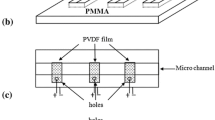Abstract
A new pressure microtransducer, which utilises a closed air volume instead of a diaphragm as the elastic medium, has been developed. Volume variations are transferred into an electrical signal via an electrolytic conductance cell, which is situated adjacent to the air volume. This arrangement eliminates the problems associated with diaphragm mounting and also gives high pressure sensitivity. The inherent nonlinearity of the input-output characteristics has a simple analytical form and can therefore be effectively reduced by an inexpensive analogue network. It is also shown that the thermal expansion of the air can be balanced by the temperature coefficient of the conductance cell. The overall performance of the sensor fulfils the requirements of most biomedical applications, and its simple and rugged construction should make it suitable for routine work.
Sommaire
On a mis au point un nouveau microtransducteur utilisant un volume d'air clos au lieu d'une membrane comme élément élastique. Les variations de volume sont converties en signal électrique par l'intermédiaire d'une cellule de conductance électrolytique située à proximité du volume d'air. Cette disposition élimine les problèmes inhérents au montage de membrane et assure également une sensibilité haute pression. La non linéarité inhérente des caractéristiques entrée et sortie présente une forme analytique simple et peut donc être réduite efficacement par un circuit analogique peu coûteux. On démontre également que la dilatation thermique de l'air peut etre équilibrée par le coefficient de température de la cellule de conductance. La performance globale du détecteur répond aux besoins de la plupart des applications biomédicales, et sa construction simple et robuste fait qu'il devrait convenir aux travaux cliniques courants.
Zusammenfassung
Ein neuer Mikrowandler fùr Druckaufzeichnungen, bei dem anstelle einer Membrane als elastisches Mittel ein eingeschlossenes Luftvolumen verwendet wird, wurde entwickelt. Die Volumenänderungen werden als elektrisches Signal über eine elektrolytische Leiterzelle übertragen, die sich in der Nähe des Luftvolumens befindet. Diese Anordnung schafft die mit der Membranenanbringung verbundenen Probleme ab und hat eine höhere Druckempfindlichkeit zur Folge. Die Nichtilinearität der Eingangs/Ausgangswerte hat eine einfache analytische Form und kann daher durch ein billiges analoges Netz wirksam reduziert werden. Es wird ferner gezeigt, daß die Wärmeausdehnung der Luft durch den Temperaturkoeffizienten der Leiterzelle ausgeglichen werden kann. Die Gesamtleistung des Meßfühlers erfùllt die Ansprüche der meisten medizinisch-biologischen Anwendungen. Durch seine einfache und robuste Ausfùhrung sollte sich das Gerät für routinemäßige klinische Arbeiten eignen.
Similar content being viewed by others
References
Geddes, L. A., Baker, L. E. andMoore, A. G. (1969) Optimum electrolytic chloriding of silver electrodes.Med. & Biol. Eng. 7, 49–56.
Geddes, L. A. (1970) The direct and indirect measurement of blood pressure, p. 49–66. Year Book Medical Publishers Inc., Chicago.
Hök, B. (1974) Electrolytic catheter-tip pressure transducer.Med. & Biol. Eng. 12, 355–359.
McCutcheon, E. P., Evans, J. M. andStanifer, R. R. (1973) Evaluation of miniature pressure transducers, in:Chronically implanted cardiovascular instrumentation. Ed.E. P. McCutcheon, pp. 21–33. Academic Press, New York.
Robinson, R. A. andStokes, R. H. (1959)Electrolyte solutions, p. 465. 2nd ed. Butterworths, London.
Schutz, E. (1931) Konstruktion einer manometrischen Sonde mit elektrischer Transmission.Z. Biol. 91, 515–521.
Author information
Authors and Affiliations
Rights and permissions
About this article
Cite this article
Hok, B. New microtransducer for physiological pressure recordings. Med. & biol. Engng. 13, 279–284 (1975). https://doi.org/10.1007/BF02477740
Received:
Accepted:
Issue Date:
DOI: https://doi.org/10.1007/BF02477740




